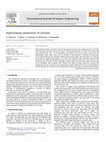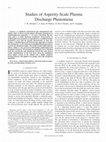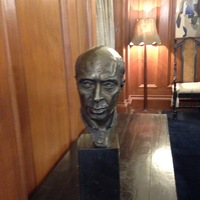Papers by Sikhanda Satapathy

Bulletin of the American Physical Society, Jun 1, 2009
Glass is being considered for various transparent armor applications due to its high compressive ... more Glass is being considered for various transparent armor applications due to its high compressive strength. However, its low tensile properties lead to cracks and fractures if significant tensile stresses are present. Presence of surface cracks in combination with high tensile stresses lead to dynamic failure, sometimes in an explosive manner. We have conducted bar impact experiments as well as ballistic tests to study their penetration behavior. Numerical simulation of these experiments is a challenge. The existing hydrocodes do not provide satisfactory results for brittle materials. This can be attributed to significant differences in constitutive behavior between brittle and ductile materials and the need to account for many fracture surfaces. A new numerical method, peridynamics---a meshless Lagrangian method solving the equation of motion in integral form---has been proposed by Stewart Silling that appears to be more suitable for modeling brittle materials. We use this method to examine the response of glass to impact loads in both bar impact and penetration experiments. This paper will discuss advantages and difficulties in modeling glass with peridynamics.
AIP Conference Proceedings, 2000
The strength of 91bar tests and in dynamic bend tests. Three materials were tested: Teledyn X27X,... more The strength of 91bar tests and in dynamic bend tests. Three materials were tested: Teledyn X27X, a preproduction batch, and a production batch of 91Tennessee. These materials were found to exhibit considerable strain rate hardening and work hardening, having dynamic flow stress of about 2 GPa. The strain to failure in dynamic bend tests was found to be about 15%.

This paper describes the new photonic Doppler velocimetry (PDV) technique for measuring time-reso... more This paper describes the new photonic Doppler velocimetry (PDV) technique for measuring time-resolved projectile velocity and acceleration profiles. This technique is shown to provide excellent temporal and spatial resolution in measurement for full flight of the launch package launched from single- and two-stage guns. The PDV method measures the minute Doppler shift in the monochromatic light reflected from the moving surface, which is directly proportional to its velocity. The Doppler-shifted laser signal is mixed with the unshifted signal to generate a beat signal. Short-time Fourier analysis of the beat signal produces highly resolved and accurate velocity profiles. Off-the-shelf components developed for the telecommunications industry are used, producing a system that is robust and inexpensive. Other examples of PDV measurements are provided in a companion paper on impact response of glass bars.
Procedia Engineering, 2015
ABSTRACT We present a methodology for concurrent Photon Doppler Velocimetry (PDV) and in-situ fla... more ABSTRACT We present a methodology for concurrent Photon Doppler Velocimetry (PDV) and in-situ flash X-ray imaging during ballistic impact of metallic penetrators into monolithic armor grade ceramic targets. Tungsten heavy alloy long rod penetrators were launched from a smooth bore cannon into silicon carbide targets at velocities of 0.753 and 1.403 mm/μs. Penetrator lengths and penetration depths were measured as a function of time using an array of four 450 kV flash X-ray sources and digital film. A four channel PDV system coupled to a 16 GHz oscilloscope was used to measure the velocity history of the penetrator and at three positions on the back surface of the target. This experimental technique shows great promise for measurements of the dwell time, penetration velocity, and the time of final break-out from the back of the target.
2008 IEEE International Power Modulators and High-Voltage Conference, 2008
In any high-energy pulsed power experiment, the metallic conductors are expected to heat up signi... more In any high-energy pulsed power experiment, the metallic conductors are expected to heat up significantly due to resistive losses. In the pulsed case, the effects of local heat transfer are decreased due to the limited thermal diffusion time, so the process is considered to be adiabatic rather than isothermal. Previous results indicate that the high-temperature mechanical properties of metallic conductors
In the penetration of semi-infinite targets the ratio of impact energy to resultant crater volume... more In the penetration of semi-infinite targets the ratio of impact energy to resultant crater volume (E/V) is a measure of the efficiency of crater formation. While efficiency in this sense does not necessarily imply efficiency in penetration depth (typically quantified as penetration per cube root of impact energy, P/E 1/3 ), it nevertheless is a useful metric. Proposed to be an inherent property of the target material [1], experimental data show that it is a function the properties of the penetrator material as well as the impact velocity .
It is well known that impact inclination is detrimental to penetration performance for long-rod p... more It is well known that impact inclination is detrimental to penetration performance for long-rod projectiles into semi-infinite targets. The drop-off in performance, measured as the depth of penetration normalized by the initial projectile length, is generally attributed to interference of the tail of the projectile with the side walls of the penetration cavity. However, little has been done to study the effect of impact inclination on the performance of long rods penetrating finite targets. A reverse ballistic experiment and three-dimensional numerical simulations are used to examine the effect of impact inclination against an oblique plate. In particular, the interaction of the projectile with the plate, to include asymmetric enlargement of the penetration channel and side loading of the projectile, are examined in the simulations, and compared to experimental results.
2007 IEEE Pulsed Power Plasma Science Conference, 2007
Summary form only given. This paper reports on the design and fabrication efforts of a supersonic... more Summary form only given. This paper reports on the design and fabrication efforts of a supersonic, high-mass electromagnetic launcher. The program goal was to efficiently accelerate an existing M933/934 mortar round to over 400 m/s. The basic electromagnetic architecture chosen was a railgun, with a detailed system study undertaken to determine the optimal railgun configuration. Operational limits required that the
Materials Science and Engineering: A, 2011
ABSTRACT This paper describes the observations of aluminum projectile (or armature) tribomaterial... more ABSTRACT This paper describes the observations of aluminum projectile (or armature) tribomaterial deposition onto copper (stator) conducting rails in an experimental solid-armature railgun system, by optical, and scanning and transmission electron microscopy. The extreme deformation at the aluminum/copper interface creates a solid-state flow regime by dynamic recrystallization which also leads to the erosion-product deposition. Melting of the low-temperature aluminum deposit also contributes to the rail damage and degradation of electromagnetic behavior. The creation of nano-grains by dynamic recrystallization allows for mixing at the aluminum/copper interface, and there is no evidence for traditional alloying.

International Journal of Impact Engineering, 2008
Experiments have been conducted with 6.25 mm diameter tungsten rods striking concrete at 2.2 km/s... more Experiments have been conducted with 6.25 mm diameter tungsten rods striking concrete at 2.2 km/s. Three concretes were useddone was 2.35 g/cm 3 and the other two were 2.27 g/cm 3 . The erosion rates were measured to be T/DL ¼ 2.4-3.1 depending on the density of the concrete. This is greater than the hydrodynamic value, which shows that the strength of the penetrator is affecting the penetration. The cratering efficiency was computed (which included surface spall) and was found to be commensurate with the strength of the concrete, 28-34 MPa. CTH calculations were conducted using the brittle fracture kinetics (BFK) and Holmquist-Johnson-Cook (HJC) material models for concrete. Density in the calculations was 2.25 g/cm 3 . It was not possible to match erosion rates at 2.2 km/s, which were too high in the calculations. Also, computed crater volumes were much too small, mainly due to spall in the experiments that was not shown in the computations. Another significant inaccuracy of the calculations was the damage extent, which became unrealistically widespread as time increased in the BFK model.
International Journal of Impact Engineering, 1999
... We have experimentally verified this assumption for yaw angles 10 and speeds to 2.6 km s for ... more ... We have experimentally verified this assumption for yaw angles 10 and speeds to 2.6 km s for tungsten penetrating armor steel [8]. Erosion can occur during ... TcpPd CV VppL O" 1+ cosz(O OJ (17) At any given time step, the angle, O and its derivative are given by, tanO = dy and ...
International Journal of Impact Engineering, 1997
... Permissions & Reprints. Penetration resistance of titanium and ultra-hard steel at elevat... more ... Permissions & Reprints. Penetration resistance of titanium and ultra-hard steel at elevated velocities. SJ Bless a , W. Gooch b , S. Satapathy a , J. Campos a and M. Lee a. a Institute for Advanced Technology, Austin, TX, USA. b Army Research Laboratory, Aberdeen PG, MD, USA ...
International Journal of Fracture, 2011
In this paper, we examine the response of a crack tip in an electrically conducting material subj... more In this paper, we examine the response of a crack tip in an electrically conducting material subjected to a combination of mechanical load as well as a high density electrical current. We present a detailed examination of the process of evolution of melting and ejection, as revealed by high speed photography. The critical mechanical and electrical parameters that govern crack extension are then determined for two different alloys. Finally, we present an evaluation of the phenomenon through a coupled field simulation to examine the nature of the interaction between the electric field and the thermo-mechanical response.

IEEE Transactions on Plasma Science, 2000
A combined experimental and computational simulation study of direct-current plasma discharge phe... more A combined experimental and computational simulation study of direct-current plasma discharge phenomena in small-length-scale geometries (< 10 µm) is described. The primary goal is to study discharge breakdown characteristics in small-length-scale geometries as quantified by a modified Paschen breakdown curve and the quench characteristics in these discharges. A modified mesoscale friction tester apparatus is used for the experiments. A self-consistent nonequilibrium plasma model is used for the simulation studies. The model includes field-emission effects, which is a key process in determining small-length-scale breakdown behavior. The breakdown and quench curves obtained from the experiments and simulations showed the same general trends. Quantification of the heat fluxes from the simulations shows higher erosion at the cathode and a highly nonlinear heating behavior with applied overvoltages above the breakdown threshold.
IEEE Transactions on Plasma Science, 2000
One innovative approach for producing functionally graded tungsten/copper composites involves inf... more One innovative approach for producing functionally graded tungsten/copper composites involves infiltrating a porous tungsten structure with molten copper. The porous structure is created by sintering tungsten powder to create an initial porous preform and then connecting the preform to the anode of an elec- trochemical cell. The porosity increases with time as the tungsten oxidizes in the alkaline electrolyte. The
IEEE Transactions on Magnetics, 2001
An important research problem for solid armature railguns is understanding the sudden transition ... more An important research problem for solid armature railguns is understanding the sudden transition from low-voltage sliding electrical contact between the rails and armature to high-voltage contact involving a plasma arc. Although an armature can fail in many ways and thereby “transition,” two distinct transition mechanisms currently limit the performance of solid armature electromagnetic (EM) launchers. One mechanism, broadly termed “wear-induced
IEEE Transactions on Magnetics, 2000
ABSTRACT
IEEE Transactions on Magnetics, 2000
The current-carrying conductors in an electromagnetic launcher are exposed to high currents that ... more The current-carrying conductors in an electromagnetic launcher are exposed to high currents that last for a few milliseconds. Surface cracks on the rails can generate large gradients in current in their vicinity and may result, in some instances, in localized melting and expulsion of rail material. Here, we report the results of a study in which the mechanical and electrical parameters of the process were monitored as a function of time and the evolution of melting and ejection was examined through high-speed photography.

IEEE Transactions on Magnetics, 2000
Experiments were conducted that simulate the time- varying mechanical and thermal conditions typi... more Experiments were conducted that simulate the time- varying mechanical and thermal conditions typically found in electromagnetic launchers. While materials that are slowly heated isothermally have adequate time for fundamental microstructural changes that weaken them to occur, the mechanical strength of metals subjected to rapidly varying, high- temperature pulses is dependent on heating rate and duration. Previous work has shown that tabulated properties of high- temperature materials inadequately describe such materials under pulsed heating conditions. In this work, ETP copper ring samples have been heated to a peak temperature in the range of 450degC over about 25 ms. The samples are first inductively preheated with low current before using a short-duration high- current pulse to expand the ring. A new photonic Doppler velocimetry system was used to accurately measure the velocity profile during the dynamic thermal and mechanical conditions. Pre-heating the specimens to 200degC resulted in a 30% drop in strength when compared to samples without pre-heating.
IEEE Transactions on Magnetics, 2000
A large-caliber railgun was developed to demonstrate the supersonic launch of 120-mm projectiles.... more A large-caliber railgun was developed to demonstrate the supersonic launch of 120-mm projectiles. A trade study that evaluated over 70 different railgun configurations and geometries resulted in the selection of a high-inductance-gradient multiturn configuration as the best overall choice. Subscale tests were performed on both the railgun and launch package configurations. A full-scale laboratory system was installed, which included a dedicated high-current large-caliber breech and gunline. A full-scale launcher was successfully tested to beyond the design conditions. This paper will describe the trade study and overall experimental program that included the subscale testing and full-scale design and experimental results.











Uploads
Papers by Sikhanda Satapathy